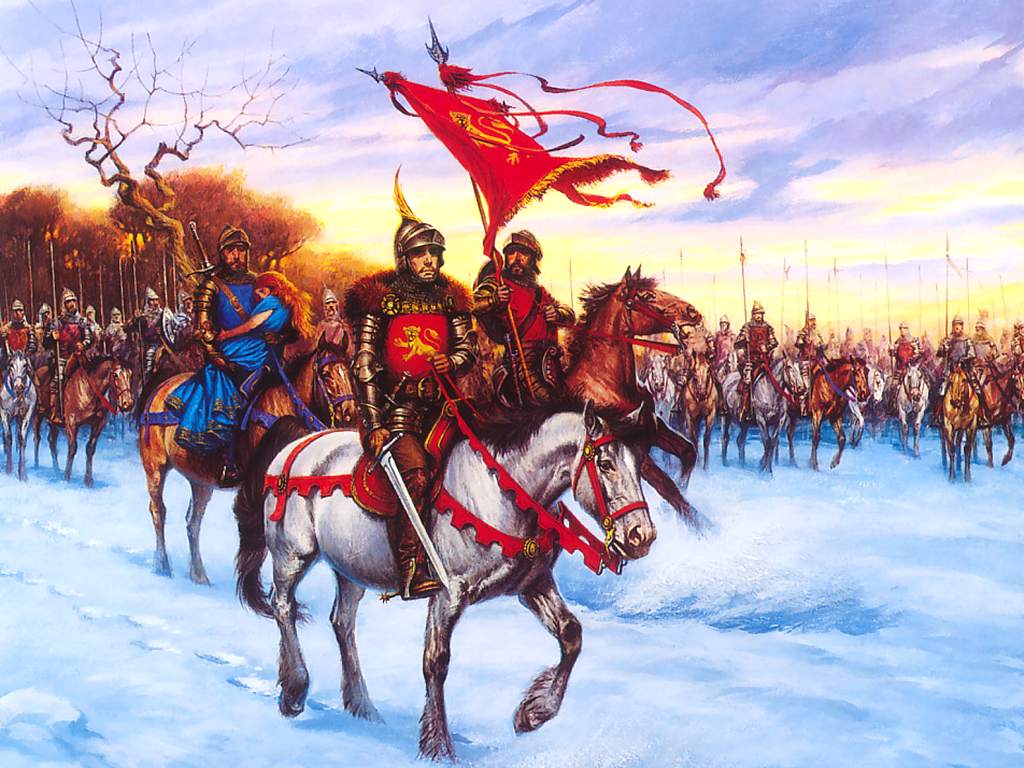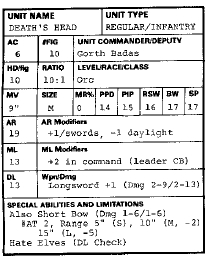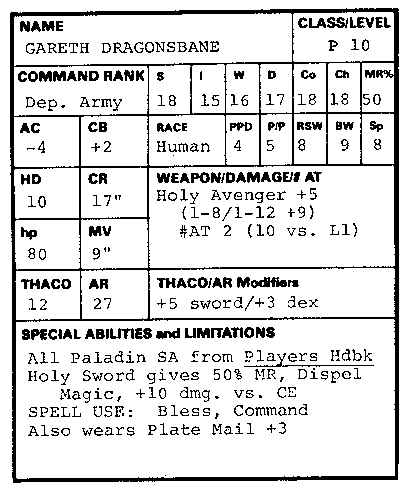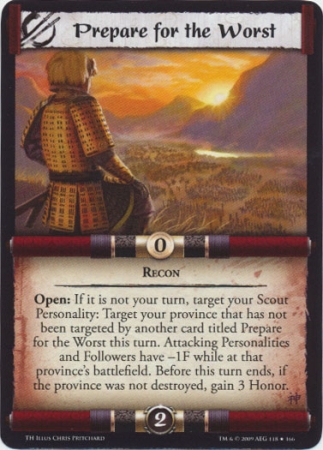3.0 SETTING UP

3.0 SETTING UP

| 3.1 Army Roster Sheet | 3.2 Heroes and Commanders Sheet | 3.3 Character Recored Sheets | 3.4 Army Placement | 3.5 Measurement |
| - | - | BATTLESYSTEM | - | - |
To play a BATTLESYSTEM game, first
select a
scenario, prepare Army Rosters, place terrain features
on
the tabletop, and set up forces for each side.
PROCEDURE
Scenarios for the BATTLESYSTEM
game can be found in the Scenario Book,
in other BATTLESYSTEM products
from TSR, Inc., or in DRAGON
magazine. In addition, you can create
your own scenarios to go with your
existing AD&D or D&D campaign
or
just create your own battle. Case [16.3]
CREATING ARMIES will help you do
that. You must first choose (or design) a
scenario, determine which players are on
which side, and arrange for playing
space. The referee, if there is one, sets up
the tabletop terrain features, or else the
players themselves set up the terrain.
Each side must prepare an Army Roster
for all forces on that side (some existing
scenarios incl. complete rosters ready
for play) and then set up their troops
(counters, minis, or a combination)
on the tabletop. All of this must be
completed before play begins.
CASES
The BATTLESYSTEM Army Roster
Sheet is used to record info about
each unit in the game. Some Army
Roster Sheets are included in this
game; you can also use blank sheets of paper to
record the necessary info. Use a
separate block to list pertinent
info for each unit.
All figures in a unit should have the
same AC, HD, and weapons,
if psb.. If a unit of mixed figures is
used (in a campaign, for example), the
unit always has the avg. ratings for
AC, HD, and damage.
Round fractions to the least favorable for
the unit.
All figures in a unit must have
the same weapon in order to FIGHT as a
unit.


This roster entry shows a force of 200
orc infantry carrying longswords +1 and
short bows (according to AD&D game
rules; some entries would be slightly
different if using D&D game rules).
Unit Name. Self-explanatory.
Unit Type. Regular, Skirmish, Mob, or
special unit type (if permitted by
scenario).
AC. Armor Class (as in the AD&D and D&D games).
HD/fig. Number of HD represented
by each figure or counter.
MV. Movement Rate in inches (from the AD&D
game).
For the D&D game,
take the movement rate per turn (no melee round!) in feet and divide
by 10
(e.g. 120' = 12").
AR. Attack Rating (see [8.2]).
AR Modifiers. Modifiers (if any) to the
Attack Rating; e.g., missile range
adjustments, magic weapons, bless spells,
etc.
ML. Base Morale (see [4.1]).
ML Modifiers. Such as morale bonus for
being in command.
DL. Discipline (see [4.6]).
#FIG. Number of figures or counters in the unit.
Ratio. Counter Ratio (see [2.2]).
Size. Of the creatures in the unit. Use S,
M, or L.
Unit Commander/Deputy. Name of Unit
Commander and Deputy Unit
Commander, if any.
Race/Class/Level. Self-explanatory.
MR%. Magic Resistance. (From the
AD&D game; anti-magic percentages
are explained in the D&D Masters Set.
If you are playing D&D Basic, Expert,
or Companion, this does not apply.)
PPD, P/P, RSW, BW, Sp. Saving throws
for figures in the unit. In the AD&D
game, PPD is Paralyzation, Poison, and
Death Magic; P/P is
Petrification/Polymorph; RSW is Rod,
Staff, or Wand; BW is Breath Weapon;
and Sp is Spells. In the D&D game,
PPD is Death Ray or Poison; P/P is
Paralysis or Turn to STone; RSW is
Magic Wands; BW is Dragon Breath; SP is
Rods, Staves, or Spells.
Weapon/Damage/#AT. Weapons used by
all members of the unit and their damage
rating (from the AD&D or D&D
game); also, number of attacks per
round.
Special Abilities and Limitations.
As appropriate for the unit, or use as
continuation space for the rest of the
form. Use additional sheets of paper if
necessary.
[3.2] HEROES AND COMMANDERS ROSTER SHEET
The BATTLESYSTEM Heroes and
Commanders Roster Sheet is used to
record info about each PC/NPC
individual in the game. You can USE the
forms that come with this game, or you
can USE blank sheets of paper to record
the necessary info. If the
PC/NPC individuals are part of your
campaign, USE their PC
Record Sheets as part of the roster.

This roster entry shows a 10th level
paladin with a holy sword and plate mail +3.
Name. Self-explanatory.
Class/Level. If any, from the AD&D
or
D&D games.
Command Rank. See [9.2] and [9.3].
If the PC/NPC individual has no command
rank whatsoever, write "Hero" in this
space.
S, I, W, D, Co, Ch. Strength, Intelligence,
Wisdom, Dexterity, Constitution, and
Charisma, from the AD&D or D&D
games. If the character is from an
existing campaign, use those stats.
For random commanders and heroes
from the AD&D game, use Method I
(DMG, p.11). For random commanders
and heroes from the D&D game, roll
3d6 for each characteristic. If the dice
result is less than the min. needed
for that race/class, use the min.
value for that race/class instead of the
actual dice roll. Not all PC/NPC
individuals need stats here. Leave
blank when appro..
Race. AD&D or D&D game monster type.
MR%. Magic Resistance. (From the
AD&D game. Anti-magic percentages
are explained in the D&D Masters Set.
If you are playing D&D Basic, Expert,
or Companion, this does not apply.)
PPD, P/P, RSW, BW, Sp. Saving throws.
See [3.1] for definition.
AC. Armor Class (as in the AD&D and
D&D gmaes).
HD. Hit Dice, if appro..
hp. # of hit points.
THACO. Base number "to hit Armor
Class Zero" from the AD&D or D&D
game (see [8.3]).
CB. Charisma Bonus (see [4.9]).
CR. Command Radius (see [4.10]).
MV. Movement Rate (in inches). See [3.1].
AR. Attack Rating (see [8.2]).
THACO/AR Modifiers. Modifiers (if
any) to either THACO or AR; e.g.
magic weapons, spells, etc. (For an
xplanation of THACO, see [8.3].)
Weapon/Damage/#AT. All weapons
carried by the character and the damage
done by each; also, the # of
attacks per round.
Special Abilities and Limitations. As
appro. for the character. USE as
continuation space if needed; USE
additional sheets of paper if necessary.
If you ar eusing important PCs and
NPCs from your role-playing campaign,
it is a good idea to have full character
info for those individuals at
hand. You should ideally prepare full
character statistics for other major PCs
or NPCs to be used. Be sure to calculate
special BATTLESYSTEM info,
such as CR, AR, and CB, for each such
character.

The scenario you are playing may
specify starting positions for all forces to
be used. If not, you may place your
forces at will. All forces should start
more than two full moves away from
their nearest opponent (if psb.), and
all forces on the same side should be on
the same side of the battle field (also if
psb.).
Decide before placing your forces whether set-up will be simultaneous
|| whether one side goes first.
For determining initial placement, it is
permitted to measure the distance
between your forces and the enemy to
ensure that you are a sufficient distance
apart. Excpet in this one instance, never
measure any proposed movement or
placement before actually declaring the
move! (See also [7.7] HOW TO MOVE.)
![]()
Reduce - Reuse - Recycle